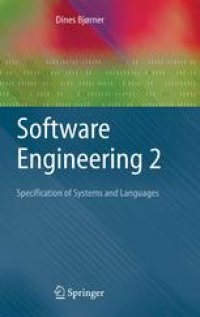
Ebook: Software Engineering 2: Specification of Systems and Languages
Author: Dines Bjørner
- Genre: Computers
- Tags: Software Engineering, Programming Techniques, Programming Languages Compilers Interpreters, Logics and Meanings of Programs
- Series: Texts in Theoretical Computer Science. An EATCS Series
- Year: 2006
- Publisher: Springer
- Language: English
- pdf
The art, craft, discipline, logic, practice and science of developing large-scale software products needs a professional base. The textbooks in this three-volume set combine informal, engineeringly sound approaches with the rigor of formal, mathematics-based approaches.
This volume covers the basic principles and techniques of specifying systems and languages. It deals with modelling the semiotics (pragmatics, semantics and syntax of systems and languages), modelling spatial and simple temporal phenomena, and such specialized topics as modularity (incl. UML class diagrams), Petri nets, live sequence charts, statecharts, and temporal logics, including the duration calculus. Finally, the book presents techniques for interpreter and compiler development of functional, imperative, modular and parallel programming languages.
This book is targeted at late undergraduate to early graduate university students, and researchers of programming methodologies. Vol. 1 of this series is a prerequisite text.
The art, craft, discipline, logic, practice and science of developing large-scale software products needs a professional base. The textbooks in this three-volume set combine informal, engineeringly sound approaches with the rigor of formal, mathematics-based approaches.
This volume covers the basic principles and techniques of specifying systems and languages. It deals with modelling the semiotics (pragmatics, semantics and syntax of systems and languages), modelling spatial and simple temporal phenomena, and such specialized topics as modularity (incl. UML class diagrams), Petri nets, live sequence charts, statecharts, and temporal logics, including the duration calculus. Finally, the book presents techniques for interpreter and compiler development of functional, imperative, modular and parallel programming languages.
This book is targeted at late undergraduate to early graduate university students, and researchers of programming methodologies. Vol. 1 of this series is a prerequisite text.
The art, craft, discipline, logic, practice and science of developing large-scale software products needs a professional base. The textbooks in this three-volume set combine informal, engineeringly sound approaches with the rigor of formal, mathematics-based approaches.
This volume covers the basic principles and techniques of specifying systems and languages. It deals with modelling the semiotics (pragmatics, semantics and syntax of systems and languages), modelling spatial and simple temporal phenomena, and such specialized topics as modularity (incl. UML class diagrams), Petri nets, live sequence charts, statecharts, and temporal logics, including the duration calculus. Finally, the book presents techniques for interpreter and compiler development of functional, imperative, modular and parallel programming languages.
This book is targeted at late undergraduate to early graduate university students, and researchers of programming methodologies. Vol. 1 of this series is a prerequisite text.
Content:
Front Matter....Pages I-XXIV
Front Matter....Pages 1-1
Introduction....Pages 3-29
Front Matter....Pages 31-33
Hierarchies and Compositions....Pages 35-53
Denotations and Computations....Pages 55-92
Configurations: Contexts and States....Pages 93-117
Front Matter....Pages 119-119
Time, Space and Space/Time....Pages 121-141
Front Matter....Pages 143-144
Pragmatics....Pages 145-150
Semantics....Pages 151-172
Syntax....Pages 173-212
Semiotics....Pages 213-239
Front Matter....Pages 241-241
Modularisation....Pages 243-283
Automata and Machines....Pages 285-312
Front Matter....Pages 313-313
Petri Nets....Pages 315-373
Message and Live Sequence Charts....Pages 375-474
Statecharts....Pages 475-516
Quantitative Models of Time....Pages 517-569
Front Matter....Pages 571-571
SAL: Simple Applicative Language....Pages 573-658
SIL: Simple Imperative Language....Pages 659-670
SMIL: Simple Modular, Imperative Language....Pages 671-680
SPIL: Simple Parallel, Imperative Language....Pages 681-706
Front Matter....Pages 707-707
Closing....Pages 709-713
Back Matter....Pages 715-777
The art, craft, discipline, logic, practice and science of developing large-scale software products needs a professional base. The textbooks in this three-volume set combine informal, engineeringly sound approaches with the rigor of formal, mathematics-based approaches.
This volume covers the basic principles and techniques of specifying systems and languages. It deals with modelling the semiotics (pragmatics, semantics and syntax of systems and languages), modelling spatial and simple temporal phenomena, and such specialized topics as modularity (incl. UML class diagrams), Petri nets, live sequence charts, statecharts, and temporal logics, including the duration calculus. Finally, the book presents techniques for interpreter and compiler development of functional, imperative, modular and parallel programming languages.
This book is targeted at late undergraduate to early graduate university students, and researchers of programming methodologies. Vol. 1 of this series is a prerequisite text.
Content:
Front Matter....Pages I-XXIV
Front Matter....Pages 1-1
Introduction....Pages 3-29
Front Matter....Pages 31-33
Hierarchies and Compositions....Pages 35-53
Denotations and Computations....Pages 55-92
Configurations: Contexts and States....Pages 93-117
Front Matter....Pages 119-119
Time, Space and Space/Time....Pages 121-141
Front Matter....Pages 143-144
Pragmatics....Pages 145-150
Semantics....Pages 151-172
Syntax....Pages 173-212
Semiotics....Pages 213-239
Front Matter....Pages 241-241
Modularisation....Pages 243-283
Automata and Machines....Pages 285-312
Front Matter....Pages 313-313
Petri Nets....Pages 315-373
Message and Live Sequence Charts....Pages 375-474
Statecharts....Pages 475-516
Quantitative Models of Time....Pages 517-569
Front Matter....Pages 571-571
SAL: Simple Applicative Language....Pages 573-658
SIL: Simple Imperative Language....Pages 659-670
SMIL: Simple Modular, Imperative Language....Pages 671-680
SPIL: Simple Parallel, Imperative Language....Pages 681-706
Front Matter....Pages 707-707
Closing....Pages 709-713
Back Matter....Pages 715-777
....